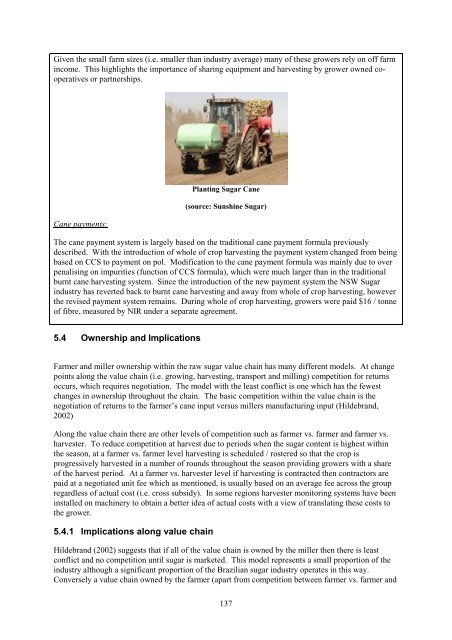Download (4Mb) - USQ ePrints - University of Southern Queensland
Download (4Mb) - USQ ePrints - University of Southern Queensland
Download (4Mb) - USQ ePrints - University of Southern Queensland
You also want an ePaper? Increase the reach of your titles
YUMPU automatically turns print PDFs into web optimized ePapers that Google loves.
Given the small farm sizes (i.e. smaller than industry average) many <strong>of</strong> these growers rely on <strong>of</strong>f farm<br />
income. This highlights the importance <strong>of</strong> sharing equipment and harvesting by grower owned cooperatives<br />
or partnerships.<br />
Cane payments:<br />
Planting Sugar Cane<br />
(source: Sunshine Sugar)<br />
The cane payment system is largely based on the traditional cane payment formula previously<br />
described. With the introduction <strong>of</strong> whole <strong>of</strong> crop harvesting the payment system changed from being<br />
based on CCS to payment on pol. Modification to the cane payment formula was mainly due to over<br />
penalising on impurities (function <strong>of</strong> CCS formula), which were much larger than in the traditional<br />
burnt cane harvesting system. Since the introduction <strong>of</strong> the new payment system the NSW Sugar<br />
industry has reverted back to burnt cane harvesting and away from whole <strong>of</strong> crop harvesting, however<br />
the revised payment system remains. During whole <strong>of</strong> crop harvesting, growers were paid $16 / tonne<br />
<strong>of</strong> fibre, measured by NIR under a separate agreement.<br />
5.4 Ownership and Implications<br />
Farmer and miller ownership within the raw sugar value chain has many different models. At change<br />
points along the value chain (i.e. growing, harvesting, transport and milling) competition for returns<br />
occurs, which requires negotiation. The model with the least conflict is one which has the fewest<br />
changes in ownership throughout the chain. The basic competition within the value chain is the<br />
negotiation <strong>of</strong> returns to the farmer’s cane input versus millers manufacturing input (Hildebrand,<br />
2002)<br />
Along the value chain there are other levels <strong>of</strong> competition such as farmer vs. farmer and farmer vs.<br />
harvester. To reduce competition at harvest due to periods when the sugar content is highest within<br />
the season, at a farmer vs. farmer level harvesting is scheduled / rostered so that the crop is<br />
progressively harvested in a number <strong>of</strong> rounds throughout the season providing growers with a share<br />
<strong>of</strong> the harvest period. At a farmer vs. harvester level if harvesting is contracted then contractors are<br />
paid at a negotiated unit fee which as mentioned, is usually based on an average fee across the group<br />
regardless <strong>of</strong> actual cost (i.e. cross subsidy). In some regions harvester monitoring systems have been<br />
installed on machinery to obtain a better idea <strong>of</strong> actual costs with a view <strong>of</strong> translating these costs to<br />
the grower.<br />
5.4.1 Implications along value chain<br />
Hildebrand (2002) suggests that if all <strong>of</strong> the value chain is owned by the miller then there is least<br />
conflict and no competition until sugar is marketed. This model represents a small proportion <strong>of</strong> the<br />
industry although a significant proportion <strong>of</strong> the Brazilian sugar industry operates in this way.<br />
Conversely a value chain owned by the farmer (apart from competition between farmer vs. farmer and<br />
137
















